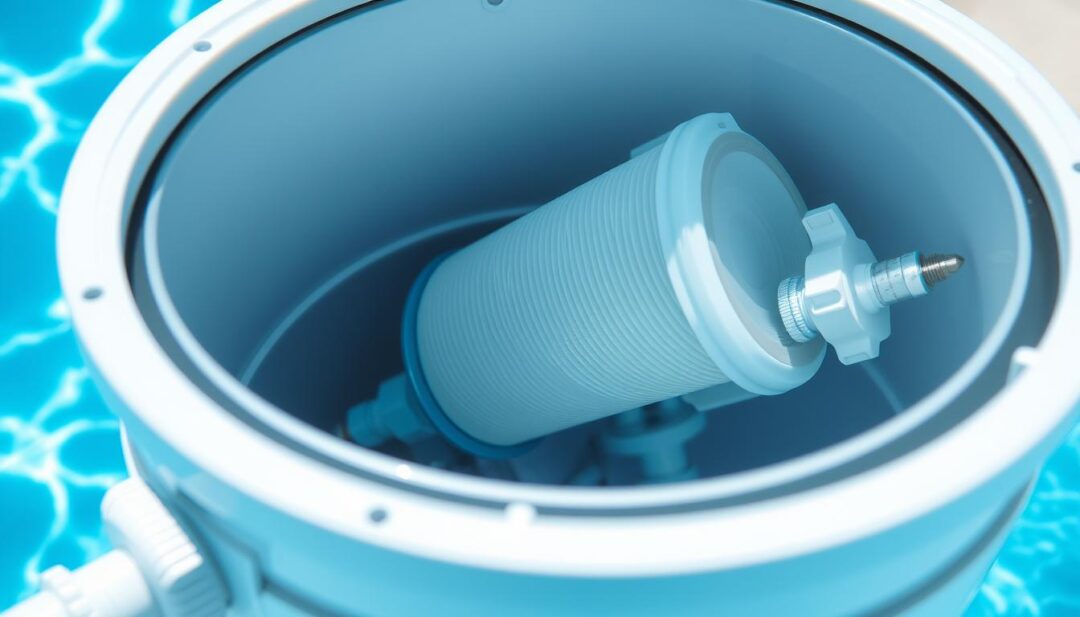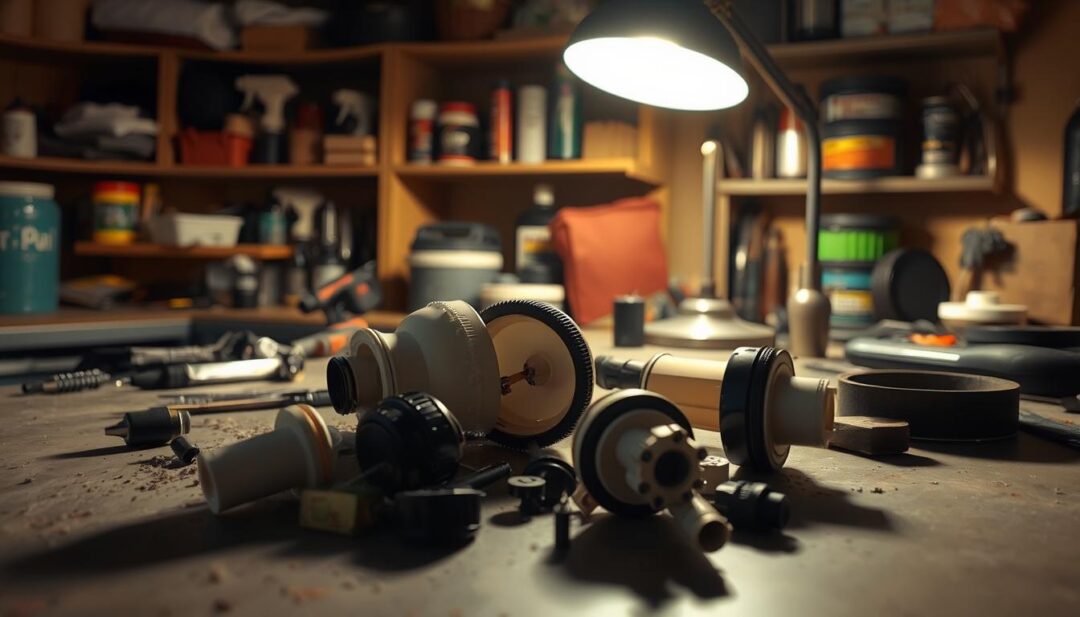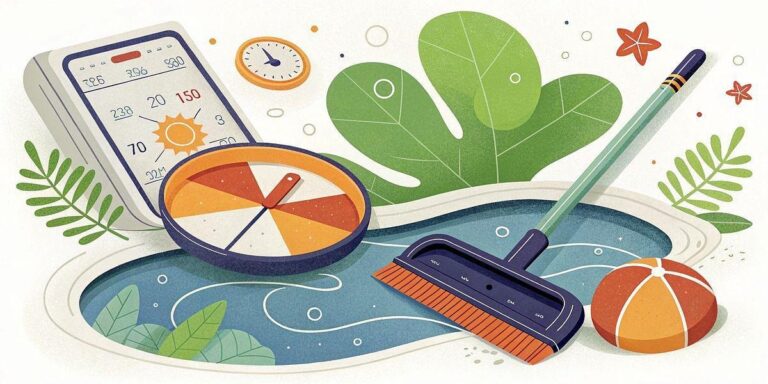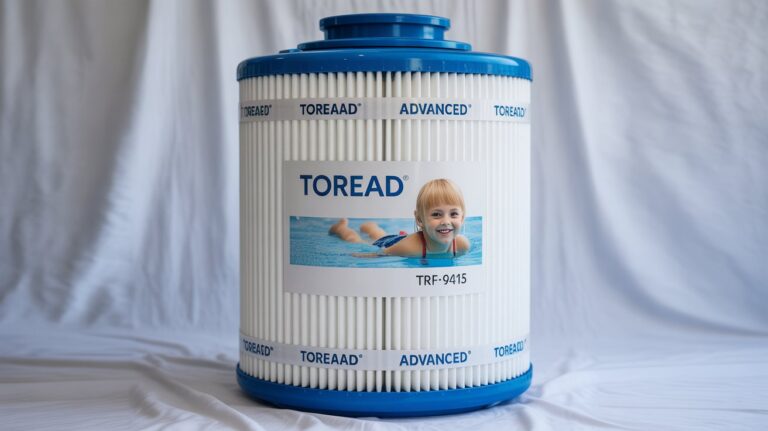Swimming Pool Filters: Everything You Need to Know
A clean and safe pool filtration system is crucial for any swimming pool owner. The right pool filter not only ensures crystal-clear water but also protects the health of those using the pool.
With so many options available, choosing the best pool filter can be overwhelming. This article aims to simplify the process by providing an overview of swimming pool filters, their types, and maintenance requirements.
Key Takeaways
- Understanding the importance of a pool filtration system
- Exploring different types of pool filters
- Learning how to maintain your pool filter for optimal performance
- Discovering the best pool filter for your specific needs
- Tips for troubleshooting common issues with swimming pool filters
The Critical Role of Filtration in Pool Maintenance
Effective pool filtration is essential for maintaining water clarity and safety. Filtration is not just about keeping the water looking clean; it’s also crucial for the health and safety of swimmers.
Why Clean Water Matters for Safety and Enjoyment
Clean water is vital for preventing the spread of waterborne illnesses. Efficient filtration removes contaminants, including bacteria, viruses, and other pathogens, ensuring a safe swimming environment. Moreover, clear water enhances the overall swimming experience, making it more enjoyable for everyone.
How Filtration Affects Water Chemistry and Clarity
Filtration significantly impacts both the chemistry and clarity of pool water. By removing impurities, filtration systems help maintain the delicate balance of water chemistry, preventing issues like algae growth and equipment corrosion. A well-maintained filtration system ensures that the water remains clear and safe.
| Filtration Aspect | Impact on Water |
|---|---|
| Removes Contaminants | Prevents waterborne illnesses |
| Maintains Water Chemistry | Prevents algae growth and equipment damage |
| Enhances Clarity | Improves swimming experience |
In conclusion, filtration is a critical component of pool maintenance, directly affecting both the safety and enjoyment of the swimming experience. Regular maintenance of the filtration system is essential to ensure it operates efficiently.
How Do Swimming Pool Filters Work?
At the heart of every swimming pool is a filtration system that works diligently to remove debris and contaminants.
The Basic Filtration Process Explained
The filtration process involves circulating pool water through a filter medium, which traps dirt and debris, allowing clean water to return to the pool.
This process is crucial for maintaining clean and safe water for swimmers.
Water Circulation System Components
The water circulation system is a critical component of the pool’s filtration system, comprising pumps and filter tanks.
Pumps and Their Function
Pool pumps are responsible for creating the flow of water that drives the filtration process, pulling water from the pool and pushing it through the filter.
Filter Tanks and Housing
The filter tanks or housing contain the filter medium and are designed to withstand the pressure of the water flowing through them.
Understanding Filter Pressure Readings
Filter pressure readings are a key indicator of the filter’s performance, with changes in pressure indicating when the filter needs cleaning or maintenance.
Types of Swimming Pool Filters Compared
The type of filter you choose for your pool can significantly impact water quality and maintenance needs. With several options available, understanding the differences between them is crucial for making an informed decision.
Sand Filters: Traditional and Reliable
Sand filters are a popular choice due to their reliability and effectiveness. They use sand as the filtering medium, trapping dirt and debris. While they require regular backwashing, they’re generally easy to maintain.
Cartridge Filters: Convenient and Efficient
Cartridge filters offer a convenient alternative, using a replaceable cartridge to filter the water. They’re known for their efficiency and ease of maintenance, although the cartridges need periodic replacement.
Diatomaceous Earth (DE) Filters: Superior Filtration
DE filters provide superior filtration, capturing very fine particles. They use diatomaceous earth as the filter medium, which needs to be replenished after backwashing.
Glass Media Filters: The Modern Alternative
Glass media filters are an eco-friendly option, using recycled glass as the filter medium. They offer good filtration efficiency and are considered a more environmentally friendly choice.
Filter Balls: The Newer Option
Filter balls are a relatively new option, made from polyester or other materials. They offer ease of use and cleaning, with some claiming they can replace traditional sand in sand filters.
Each type of filter has its advantages and disadvantages, and the best choice depends on your specific pool needs, maintenance preferences, and budget.
Sand Filters: In-Depth Analysis
Sand filters are a traditional yet effective solution for pool water filtration, using sand as the primary filter medium. They have been a staple in pool maintenance for decades, providing a reliable method for removing dirt and debris from the water.
How Sand Filters Work
Sand filters operate by pumping pool water through a bed of sand, which traps dirt and debris, allowing clean water to pass through. The sand acts as a mechanical barrier, filtering out particles as small as 20-40 microns. As the water circulates, the sand is periodically cleaned through a process called backwashing.
Pros and Cons of Sand Filtration
The advantages of sand filters include their relatively low maintenance cost and ease of use. However, they also have some drawbacks, such as the need for periodic backwashing and the eventual replacement of the sand.
| Pros | Cons |
|---|---|
| Low maintenance cost | Periodic backwashing required |
| Easy to use | Eventual sand replacement needed |
When to Change Swimming Pool Filter Sand
The sand in a sand filter typically needs to be replaced every 5-7 years, depending on usage and maintenance. Signs that it’s time to change the sand include decreased filter performance and cloudy pool water.
Cost Considerations for Sand Filters
The initial cost of a sand filter can vary depending on the size and quality of the filter. Ongoing costs include the cost of replacing the sand and occasional maintenance.
Cartridge Filters: Complete Guide
Among the various types of pool filters available, cartridge filters stand out for their unique benefits. Cartridge filters use a replaceable cartridge as the filter medium, making them known for their convenience and efficiency.
How Cartridge Filters Work
Cartridge filters operate by using a pleated cartridge that traps dirt and debris, allowing clean water to pass through. The cartridge is typically made of a synthetic material that is designed to capture particles as small as 10-15 microns. This process ensures that the water in your pool remains clean and safe for swimming.
Advantages and Disadvantages
The advantages of cartridge filters include their ease of maintenance, as they don’t require backwashing like sand filters do. They also provide superior filtration, capturing smaller particles than sand filters. However, the cartridges need to be replaced periodically, which can be a disadvantage. Additionally, cartridge filters can be more expensive to operate in the long run due to the cost of replacement cartridges.
Replacement Frequency and Costs
The frequency of replacing cartridge filters depends on various factors, including the size of your pool, the amount of use, and the surrounding environment. On average, cartridge filters need to be replaced every 1-3 years. The cost of replacement cartridges can vary, but it’s essential to factor this into your overall cost of ownership when choosing a cartridge filter.
Are Pool Filter Cartridges Universal?
While there are various cartridge filters available, they are not all universal. Different manufacturers design their cartridges to fit specific filter housings. Therefore, when replacing a cartridge, it’s crucial to ensure that you purchase one that is compatible with your filter system.
In conclusion, cartridge filters offer a convenient and efficient solution for pool owners. By understanding how they work, their advantages and disadvantages, and the costs associated with replacement, you can make an informed decision about whether a cartridge filter is the right choice for your pool.
Diatomaceous Earth Filters: Expert Breakdown
Diatomaceous Earth (DE) filters are renowned for their exceptional filtration capabilities, making them a popular choice among pool owners. These filters use diatomaceous earth as the filter medium, which is composed of the fossilized remains of tiny aquatic organisms called diatoms.
The Science Behind DE Filtration
The science behind DE filtration lies in its ability to capture particles as small as 2-5 microns, including dirt, debris, and even some bacteria. This is achieved through the intricate structure of diatomaceous earth, which provides a large surface area for filtration.
Benefits and Limitations of DE Filters
DE filters offer several benefits, including superior water clarity and the ability to remove a wide range of contaminants. However, they also have some limitations, such as requiring regular maintenance and being more expensive than some other filter types.
Safety Considerations When Using DE
When using DE filters, it’s essential to take safety precautions to avoid inhaling the fine powder, which can cause respiratory issues. Pool owners should handle DE with care and follow the manufacturer’s instructions for safe use.
Cost Analysis of DE Filtration
The cost of DE filtration includes the initial purchase of the filter, ongoing maintenance costs, and the cost of replacing the DE powder. While DE filters may be more expensive upfront, their superior performance can lead to long-term savings on chemical treatments and other maintenance costs.
Choosing the Right Swimming Pool Filters for Your Needs
A suitable pool filter is essential for an enjoyable and healthy swimming experience. With various types of filters available, selecting the right one can be challenging.
Factors to Consider When Selecting a Filter
Several factors come into play when choosing a pool filter. These include:
Pool Size and Volume
The size of your pool directly affects the type of filter you need. Larger pools require filters with higher flow rates to maintain clean water.
Usage Patterns and Bather Load
Pools with heavy usage or high bather loads require more efficient filters to handle the increased contaminant load.
Local Climate Considerations
Climate can impact filter performance. For example, pools in areas with high debris or pollen may require filters with finer filtration capabilities.
Budget Considerations: Initial vs. Long-term Costs
When selecting a filter, consider both the initial purchase price and long-term operating costs. Some filters may be cheaper upfront but more expensive to maintain over time.
Are Pool Filters Interchangeable or Universal?
While some pool filters are designed to be versatile, not all filters are interchangeable. It’s essential to choose a filter compatible with your pool’s specific needs and equipment.
Pool Filter Sizing: Getting it Right

Getting the right size for your pool filter is crucial for effective filtration and overall pool health. A correctly sized filter ensures that your pool water remains clean, clear, and safe for swimmers.
Understanding Filter Flow Rates
Filter flow rate is a critical factor in determining the correct size of your pool filter. It measures the volume of water that can pass through the filter in a given time, usually expressed in gallons per minute (GPM). To calculate the required flow rate, you need to consider the total volume of your pool and the desired turnover rate.
Calculating the Correct Filter Size for Your Pool
To calculate the correct filter size, you must first determine your pool’s surface area and volume. Then, consider the filter’s flow rate and the pump’s horsepower. A general rule of thumb is to choose a filter that can handle at least the total volume of your pool in a certain number of hours, typically 8-10 hours.
Signs Your Filter is Undersized
An undersized filter can lead to poor water quality and increased maintenance costs. Signs that your filter might be undersized include cloudy or dirty water, increased pressure on the filter gauge, and reduced water circulation. If you notice any of these issues, it may be time to reassess your filter size.
Filter Location Considerations
The location of your pool filter can also impact its performance. Ideally, the filter should be placed in a well-ventilated area, protected from the elements, and close to the pool pump. Proper placement can help ensure efficient operation and simplify maintenance tasks.
Installation Guide for Pool Filtration Systems
When it comes to installing a pool filtration system, homeowners have the option to either DIY or hire a professional. This decision largely depends on the complexity of the system, the homeowner’s level of expertise, and local regulations.
DIY vs. Professional Installation
DIY installation can be cost-effective but requires a good understanding of plumbing and electrical systems. On the other hand, professional installation ensures that the job is done correctly and efficiently, often with a warranty.
- Cons of DIY Installation: Risk of incorrect installation, potential safety hazards.
- Pros of Professional Installation: Expertise, warranty, compliance with local codes.
- Cons of Professional Installation: Higher upfront costs, dependence on the installer’s schedule.
- Pros of DIY Installation: Potential cost savings, flexibility in scheduling.
Step-by-Step Installation Process
The installation process involves several key steps:
- Preparation: Shut off the power to the pool equipment and ensure the area is clear.
- Filter Placement: Position the filter according to the manufacturer’s instructions.
- Plumbing Connections: Connect the filter to the pool plumbing, ensuring all connections are secure.
- Electrical Connections: Wire the filter and pump to the control panel, following local electrical codes.
- Testing: Turn on the system and check for leaks or other issues.
Common Installation Mistakes to Avoid
Common mistakes include improper sizing of the filter for the pool, incorrect plumbing connections, and failure to follow local building codes.
Total System Costs: Filters, Pumps, and Installation
The total cost of a pool filtration system includes the filter, pump, installation labor, and any additional components required. On average, the cost can range from $1,000 to $3,000 or more, depending on the system’s complexity and size.
Understanding these aspects can help homeowners make informed decisions when installing a pool filtration system, ensuring their pool water remains clean, safe, and enjoyable.
How to Clean Swimming Pool Filters Properly
To keep your pool water sparkling, understanding how to clean your pool filter is key. Regular cleaning is essential for maintaining the effectiveness of pool filters, ensuring your pool remains safe and enjoyable for everyone.
Effective Methods for Sand Filters
Cleaning sand filters involves backwashing, a process that reverses the flow of water to remove dirt and debris trapped in the sand. It’s crucial to do this regularly to prevent the sand from becoming too clogged, which can reduce the filter’s efficiency. “Backwashing is a simple yet effective way to maintain your sand filter,” as noted by pool maintenance experts.
Techniques for Cartridge Filters
For cartridge filters, cleaning involves removing the cartridge and hosing it down to remove dirt. For more thorough cleaning, soaking the cartridge in a filter cleaning solution can be effective. It’s important to let it dry completely before reinstalling to prevent any bacterial growth.
Maintenance for DE Filters
Diatomaceous Earth (DE) filters require backwashing similar to sand filters, but they also need recharging with new DE powder after cleaning. This ensures the filter continues to remove small particles and contaminants from the pool water effectively.
Professional vs. DIY Cleaning
While DIY cleaning can be cost-effective, professional cleaning services can provide a more thorough clean, especially for complex filter systems. It’s worth considering professional services if you’re unsure about the best cleaning methods for your specific filter type.
Reusing Pool Filters After Cleaning
Most pool filters can be reused after cleaning, provided they are in good condition. However, cartridge filters may need replacement more frequently than sand or DE filters. Regular inspection will help determine if a filter can be reused or needs replacement.
Backwashing Your Pool Filter: Essential Guide
The process of backwashing is vital for the longevity and effectiveness of certain types of pool filters. Backwashing involves reversing the flow of water through the filter to remove dirt and debris that have accumulated, which is crucial for maintaining clean and safe pool water.
When Should a Pool Filter Be Backwashed?
Knowing when to backwash your pool filter is key to maintaining its efficiency. Typically, you should backwash when the pressure gauge indicates an increase of 8-10 psi over the normal operating pressure. This is a sign that the filter is clogged and needs cleaning. Regular backwashing ensures that your filter continues to function properly, keeping your pool water clear and reducing the need for chemical treatments.
Step-by-Step Backwashing Instructions
Backwashing your pool filter is a straightforward process that can be done in a few steps:
- Turn off the pool pump and switch the filter valve to the “backwash” position.
- Turn on the pump and let it run until the water in the sight glass is clear, usually 2-3 minutes.
- Turn off the pump, switch the valve to the “rinse” or “re-filter” position, and run the pump for about 30 seconds to reset the filter.
- Return the valve to the “filter” position and resume normal operation.
Why Backwashing is Important for Filter Health
Regular backwashing is essential for maintaining the health of your pool filter. By removing accumulated debris, backwashing prevents clogging, reduces pressure on the filter, and ensures that water can flow freely. This not only improves the filter’s efficiency but also prolongs its lifespan, saving you money on premature replacements.
Water Conservation Considerations
While backwashing is necessary for filter maintenance, it’s also important to consider water conservation. Modern pool filters and backwashing systems are designed to minimize water waste. To conserve water, backwash only when necessary, and consider using a pool filter that requires less water for backwashing. Additionally, reusing backwash water for irrigation or other non-potable purposes can further reduce water waste.
Troubleshooting Common Pool Filter Problems

Common pool filter problems can often be resolved with simple troubleshooting steps. Pool filters are crucial for maintaining clean and safe water, but like any mechanical system, they can encounter issues.
Low Pressure Issues and Solutions
Low pressure in your pool filter can indicate a problem with the pump or filter system. Check for clogs in the skimmer or pump baskets, and ensure the pump is primed correctly. If the issue persists, inspect the filter for damage or excessive dirt buildup.
High Pressure Problems and Fixes
High pressure, on the other hand, often signifies a clogged filter or blocked pipes. Cleaning or replacing the filter element can usually resolve this issue. Additionally, check for any blockages in the return lines or valves.
Cloudy Water Despite Filtration
If your pool water remains cloudy despite filtration, it may indicate inadequate filter sizing or poor circulation. Ensure your filter is appropriately sized for your pool volume and that the circulation system is functioning correctly.
Leaks and Physical Damage
Inspect your filter system for any signs of leaks or physical damage. Leaks can lead to decreased filter performance and increased energy costs. Replace any damaged parts promptly.
Why Is My Pool Filter So Loud?
Unusual noises from your pool filter can be due to air leaks, worn-out pump parts, or improper installation. Check for air leaks in the suction line and ensure all connections are secure.
| Issue | Possible Cause | Solution |
|---|---|---|
| Low Pressure | Clogged skimmer or pump baskets | Clean baskets and check pump priming |
| High Pressure | Clogged filter or blocked pipes | Clean or replace filter, check for blockages |
| Cloudy Water | Inadequate filter size or poor circulation | Check filter size and circulation system |
When to Replace Your Pool Filter Components
Understanding when to replace your pool filter components can save you money and hassle in the long run. Regular maintenance and timely replacement of these components are crucial for maintaining a clean, safe, and healthy swimming environment.
Lifespan of Different Filter Types
The lifespan of pool filter components varies significantly depending on the type of filter. For instance, sand filters typically need their sand replaced every 5-7 years, while cartridge filters may need to be replaced every 2-5 years, depending on usage and maintenance. Diatomaceous earth (DE) filters, on the other hand, require their DE powder to be replenished after each backwash.
Signs It’s Time for a Replacement
There are several signs that indicate it’s time to replace your pool filter components. These include a significant decrease in water flow, increased pressure gauge readings, and visible signs of wear and tear on the filter components. If you notice any of these signs, it’s essential to assess the condition of your filter components and consider replacement.
Upgrading vs. Replacing with the Same Model
When deciding whether to upgrade or replace with the same model, consider factors such as improved efficiency, cost savings, and enhanced performance. Upgrading to a newer model can offer better filtration and potentially lower energy costs, while replacing with the same model ensures compatibility and simplicity.
Cost of Replacement Parts vs. New Systems
The cost of replacement parts versus new systems is another critical consideration. While replacing individual components can be cost-effective in the short term, it’s essential to consider the long-term benefits of upgrading to a new system, which may offer improved efficiency and reduced maintenance costs.
Pool Filter Operation: Timing and Efficiency
Pool filter operation affects not only the cleanliness of the pool but also energy consumption. Running your pool filter for the right amount of time is crucial for maintaining water clarity while minimizing energy costs.
How Often Should a Pool Filter Run?
The frequency of pool filter operation depends on several factors, including pool size, usage, and the type of filter. Generally, it’s recommended to run the filter for at least 8 hours a day during peak swimming season. Increasing the run time during heavy usage periods can help maintain water quality.
Seasonal Adjustments to Filter Operation
As the swimming season changes, so should your filter operation. During colder months or when the pool is not in use, you can reduce the filter run time. Adjusting the filter operation seasonally can help save energy and prolong the life of your filter.
Can You Swim with the Pool Filter Running?
Yes, you can swim with the pool filter running. In fact, running the filter during swimming hours can help maintain cleaner water. However, it’s essential to ensure that the filter is properly maintained and that the water circulation is not too strong.
Energy Costs of Running Your Pool Pump
The energy costs associated with running your pool pump can be significant. Using a variable speed pump and optimizing the filter run time can help reduce energy consumption and lower your utility bills.
Advanced Filtration Technologies and Alternatives
Beyond traditional filtration methods, advanced technologies are now available to enhance pool water quality and safety. These innovations offer pool owners more options to achieve cleaner, healthier water with potentially less maintenance.
Salt Water Systems and Their Filtration Requirements
Salt water systems are becoming increasingly popular for their ability to provide a gentler swimming experience. These systems use a saltwater chlorine generator to sanitize the water, reducing the need for traditional chlorine. However, they still require a robust filtration system to remove debris and contaminants.
UV and Ozone Supplemental Filtration
UV and ozone systems are advanced technologies used to supplement traditional filtration. UV light can kill bacteria and other microorganisms, while ozone is a powerful oxidizer that can reduce contaminants. Both can significantly improve water quality when used alongside a conventional filter.
Smart Pool Technology and Automated Filtration
Smart pool technology integrates automation and advanced sensors to optimize filtration and other pool systems. These systems can monitor water quality in real-time and adjust filtration cycles accordingly, potentially saving energy and improving water clarity.
Can Pool Water Be Filtered for Drinking?
While advanced filtration systems can significantly improve pool water quality, it’s generally not recommended to drink pool water. Pool water contains chemicals and contaminants that are not removed by standard filtration systems, making it unsafe for consumption.
Conclusion: Maximizing Your Pool Filter Investment
Proper maintenance and operation of your pool filter are crucial to maximizing your investment. By understanding the different types of filters, their operation, and maintenance needs, you can make informed decisions to keep your pool water clean and safe.
Effective filtration is key to maintaining clear and healthy pool water. Regular cleaning and backwashing of your filter, along with proper sizing and installation, will ensure optimal performance. By following the guidelines outlined in this article, you can extend the lifespan of your pool filter and reduce energy costs.
Maximizing your pool filter investment also involves considering advanced filtration technologies and alternatives, such as salt water systems and smart pool technology. By staying informed about the latest developments in pool filtration, you can make the most of your investment and enjoy a cleaner, healthier pool.
By prioritizing pool filter maintenance and effective filtration, you can ensure a safe and enjoyable swimming experience. With the right knowledge and practices, you can protect your investment and enjoy your pool for years to come.






